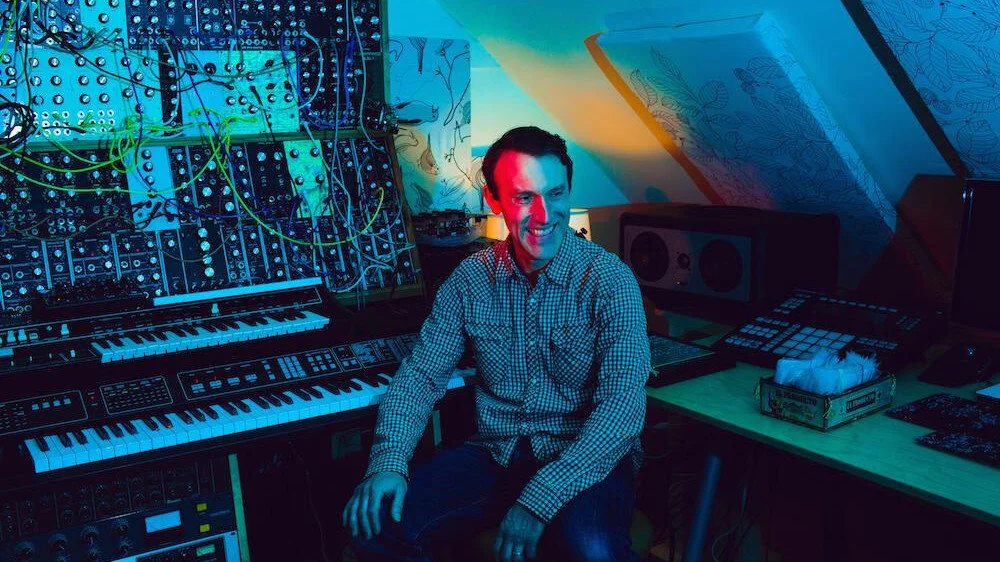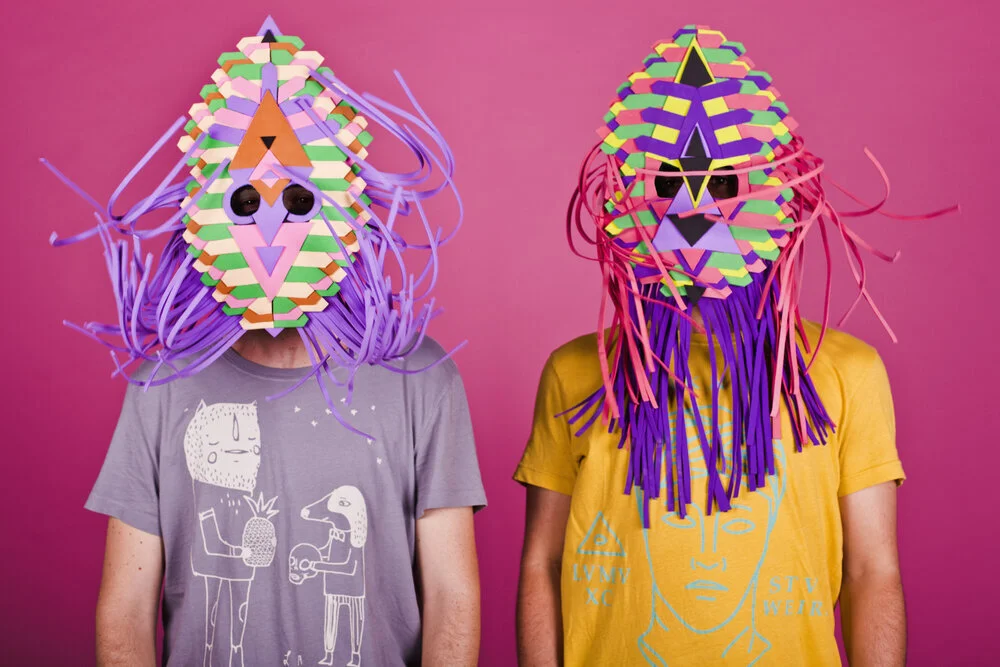Exclusive Interview: RJD2 on Dame Fortune
RJD2’s new album Dame Fortune finds the Philadelphia producer splashing in the shallow end of the pool before diving into its murky depths. This balance—offsetting the playful with the weighty, both thematically and in production style—has been present in his work since his Deadringer debut.
The classic four-bar breaks and soul-tinged production of RJD2’s Deadringer were born of his roots as a Philadelphia hip-hop DJ. The sound was innovative in 2002 (and remains fresh) by galvanizing classic hip-hop sounds, rolling drums, triumphant horns, and samples with moody keys of artists like DJ Spooky and DJ Shadow. The result feels forged in steel, solid, and fortified.
Deadringer’s highlight, “Smoke and Mirrors,” found RJD2 sampling Marion Black of Capsoul Records 1970 track, “Who Knows”, and updating its haunting lyrics. Elsewhere, the cinematic “Chicken-Bone Circuit” swaps restrained keys and rolling, John Bonham-style drums, moody violin, and samples of girls gossiping, all culminating in a flurry of robotic synths.
RJD2 has collaborated with numerous artists throughout this tenure. He worked with rappers Blueprint as Soul Position, releasing royal albums such as Things Go Better With RJ and Al on the regal Rhymesayers Entertainment label before collaborating with Son Little (Aaron Livingston) as Icebird in 2011’s The Abandoned Lullaby, an album created with mostly vintage synth sounds and DIY equipment. He told Wired, an estimated 90 percent of the sounds come from either vintage synthesizers he restored or instruments played through modular synth gadgets he built from DIY kits. In other projects such as MHz, RJD2 unites with rappers Copywrite, Tage Future, Jakki Da Motamouth and the late Camu Tao. His instrumental track, “A Beautiful Mine,” is probably his best-known work as the theme song for Mad Men.
Yet RJD2 isn’t resting on his laurels. Dame Fortune arrived on the artist’s own label, RJ’s Electrical Connections. Thematically, the album spits sober commentary on the darker corners of human nature — apathy, sensationalism and shallow vanity — and elsewhere pokes fun at the plight.
“When I hear people talk of peace in America, the discrepancy between our words and our actions can get fatiguing,” he says. “I was trying to reflect the experience of people I know, which often feels like we’re not actually trying to do anything about problems in our country.”
We got RJD2 on the phone to ask him about vintage modular synthesizers, dad duty, and doing it for love.
You’re originally from Philadelphia, but relocated to the Midwest recently. Where are you now? Do you have culture shock?
I moved to Columbus, Ohio, with my family. I grew up in Columbus, and have a four-year-old, so for the sake of being near family, we elected to move here. Being back in the Midwest is different, and I’m making the best of it. Anywhere that you live has its pros and cons, so you just kinda roll with the punches. The cost of living is cheaper here, but it’s a trade-off.
What are you trading? Culture for family and comfort?
Yeah, but it’s cool. Columbus has gone through this resurgence in the past 10 years. It’s got a burgeoning entrepreneurial environment or scene or whatever you want to call it and is a great place for food, coffee and beer. I’m not a massive beer connoisseur, per se, but the beer scene is huge. Most people say that we’ve got a better beer scene than New York City.
What’s your process for making music these days?
I’d say the best way to describe it is over the years, I’ve taken on different tools, and those tools became part of an arsenal. At the core, I’m recording by digital interface. My first record was recorded onto an ADAT machine via MPC-2000 sampler, which I still use to this day. I record with ProTools. I do vocal arrangements in an Akai MPC-2000. Today I use the MPC as more of a rhythmic tool, chopping up samples and making them sound a particular way, but I don’t do that on every song. Early on, I wanted to have more tools in my stable, so I’ve gone down that route of live instrumentation, drums, guitars, keyboards, analog synths, and to a lesser degree, vintage microphones, preamps and micro-compressors.
It’s a great time to be a producer — software provides affordable access to musicians, and companies like Moog are reproducing classic modular synths with limited reproduction runs of the System 55 and Model 15.
Yes. Just this week I’ve set up a system to interface a modular synthesizer I’ve been building since 2008, and I have a bunch of old analog synths. I’ve just figured out how to convert MIDI, giving me the playability and arrangement of a fully modern system, but the actual audio sources were made before 1975. It is the best of both worlds situation. It’s the golden age of DIY modular synthesis. There’s a bunch of people that go the pre-made route, but often people switch over to buying kits they build themselves.
What synths and pre-made kits do you work with?
I’m a fan of production line and older synths like the CS-80, Yamaha poly-synths, the Minimoog, Arp X, the Roland Jupiter-8, the Dave Smith Instruments Prophet, Polymoog and ARP 2600. I have a modular system built out with four voices, or four banks, and each bank is set up to be an independent voice with an oscillator filter, VCA and envelopes to control. I set it up that way so I can play it with four-voice polyphony. Geddy Lee from Rush said in relation to synthesizers, “One is too many, and a hundred ain’t enough.”
Wow, that’s quite an arsenal you’ve got there. Do you see Dame Fortune as an album with continuity, as it in it hangs together with context and a message?
About half of the songs are instrumental, and half are vocal. The vocal songs are about a number of different things. The point of it is that it’s beyond the scope of words. The beauty of it is that it can express an emotion that cannot be expressed in words, at least for me. I wouldn’t call it a concept album, by any stretch.
How do you feel that you’ve progressed as an artist with this album?
Whether any artist likes it or not, by definition they’re always progressing. It’s rare that I hear an artist that does the exact same thing two albums in a row. With this record, I feel like I’ve come to a place as a producer that I’m comfortable with some levels of both minimalism and calm, scaling things back. There are passages in this record that show a level of patience and letting things unfold slowly, not feeling a rush into bombast and loudness and throwing sounds at people to try and get their attention.
Sometimes that progress as an artist is learning how to remove themselves from the equation and be a vessel for their creativity. It’s not about ego.
Yes. You don’t have to shout in every conversation to get everyone’s attention. Metaphorically speaking, I’m not shouting.
Now that you’re a father, how do you balance your family time with being on the road?
I’m going to finish this interview and be on dad duty, which I love, whereas before I wouldn’t have to think about what I’d be doing at 3:05 p.m. You just figure it out as you go. It’s totally worth it — I don’t say that with any sense of regret. You just do it.
What do you make of the changes in music since your first album, Deadringer?
Deadringer came out in 2002. I’ve seen so much. In the current musical landscape, you can’t afford to be a complete and total Luddite. I’m not trying to imply that everyone should be on Facebook and Twitter 24 hours a day, but by definition, if you’re making a living in the music industry, you’ve got to be on social platforms, and 95 percent of your business takes place over email. Someone with a guitar and a phone in a room somewhere can’t make a living any more. It’s been an interesting evolution—people either sink or swim. I’ve seen people not be able to navigate a digital environment, and I feel like I got lucky in that I came out of such a bootstrap environment. I was just winging it, taking any DJ gig I could get, and linking up with any person I could to make records. I was at Kinko’s running off mixtape covers until 11 p.m. I designed stuff and sat at the library of my high school in 1997 so I could use Photoshop to lay out my CD cover.
It’s not just that it’s analog. Everything was new. Every turn of events required you to learn. I feel lucky, because we were forced to come into this world and we had to learn. Things really started shifting fast, and we were already in gear, not just parked in the garage.
Any sage advice for new music producers?
Make sure you’re having fun. You might be able to have a career, or not, but one thing you can do is destroy a thing that’s fun to you. There are two things I’m confident about: you can have fun, or potentially corrupt what is fun and turn it into something you don’t like to do any more. Your best shot at making a career is to be good at what you do. Most often, that happens by doing what you love. You’ve gotta love what you do, and then it’s not work.
Image © Roli.com
Article originally written for Napster.


